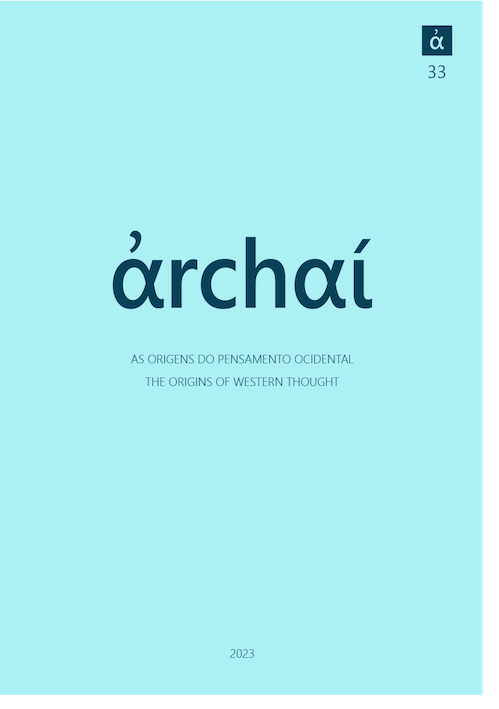La distinción entre la filosofía y el kata philosophian logos en el estoicismo
DOI:
https://doi.org/10.14195/1984-249X_33_29Palavras-chave:
Discurso, Enseñanza filosófica, Crisipo, Razón, Zenón de TarsoResumo
Este artículo se ocupa de responder cuál sería la distinción que los estoicos establecerían entre la filosofía y el kata philosophian logos, acorde al reporte de D.L., VII, 39-41. En este lugar me aparto de los estudiosos que consideran que la distinción es ontológica, es decir, quienes proponen que el kata philosophian logos haría referencia a la presentación discursiva de los dogmas estoicos, cuya naturaleza es incorpórea, en tanto que la filosofía haría referencia a una disposición del alma, cuya naturaleza sería corpórea. Propondré, más bien, que los dos son disposiciones o estados de la parte racional del alma, y que la diferencia entre ellos está en el grado de perfección que han alcanzado.
Downloads
Referências
ANNAS, J. (2007). Ethics in Stoic Philosophy. Phronesis 52, n. 1, p. 58-87.
ARMISEN-MARCHETTI, M. (2020). La philosophie selon Sénèque: apprentissage ou révélation? In: AYGON, J.; COURTIL, J.; RIPOLL F. (eds.), Seneca Saepe Noster, Articles de Mireille Armisen-Marchetti sur l´oeuvre de Sénèque (1981-2013) réunis en son honneur. Bordeaux, Ausonius Éditions.
ARNIM, I. (1964). Stoicorum Veterum Fragmenta (=SVF). 3 vols. Stuttgard, Teubner.
BARNES, J. (1999). Language. In: ALGRA, K.; BARNES, J.; et al (eds.). The Cambridge History of Hellenistic Philosophy Cambridge, Cambridge University Press, p. 193-213.
BOERI, M.; SALLES, R. (2014). Los Filósofos Estoicos: Ontología, lógica, física y ética (= BS). Sankt Augustin, Academia Verlag.
BOYS-STONES, G. R. (2001). Post-Hellenistic Philosophy: A Study of its Development from the Stoics to Origen Oxford/ New York, Oxford University Press.
BOYS-STONES, G. R. (2003). The Stoic´s Two tipes of Allegory. In: BOYS-STONES, G. R. (ed.). Metaphor, Allegory and the Classical Tradition Oxford/ New York, Oxford University Press, p. 189-216
BRITTAIN, C. (2001). Philo of Larissa Oxford/New York, Oxford University Press.
BRITTAIN, C. (2005). Common Sense: Concepts, Definition and Meaning in and out of the Stoa. In: FREDE, D.; INWOOD, B. (eds.). Language and Learning, Philosophy of Language in the Hellenistic Age Cambridge, Cambridge University Press , p. 164-209.
BROUWER, R. (2014). The Stoic Sage, the early stoics on wisdom, sagehood and Socrates. Cambridge, Cambridge University Press .
CHERNISS, H. (1976). Plutarch. Moralia, v. 13, n. 2. Cambridge/Massachusetts/London, Harvard University Press.
DOMARADZKI, M. (2012). Theological Etymologizing in the Early Stoa. Kernos 25, p. 125-48.
DORANDI, T. (ed.) (2013). Diogenes Laertius. Lives of Eminent Philosophers Cambridge, Cambridge University Press .
DYSON, H. (2009). Prolepsis and Ennoia in the Early Stoa New York/Berlin, Walter de Gruyter.
FREDE, M. (1994). The Stoic Conception of Reason. In: BOUDOURIS, K. (ed.). Hellenistic Philosophy, v. 2. Athens, International Center for Greek Philosophy and Culture, p. 50-63.
HADOT, P. (1979). Les divisions des parties de la philosophie dans lʼAntiquité. Museum Helveticum 36, P. 201-223.
HADOT, P. (1991). Philosophie, discours philosophique, et divisions de la philosophie chez les Stoiciens. Revue Internationale de Philosophie 45, n. 178, p. 205-219.
HADOT, P. (2006). Ejercicios Espirituales y Filosofía Antigua Trad. Javier Palacio. Madrid, Ediciones Siruela.
HÜLSER, K. (1987). Die Fragmente zur Dialektik der Stoiker (=FDS). Vol 1 y 2. Stuttgart / Bad Cannstatt, Friedrich Frommann Verlag.
IERODIAKONOU, K. (1993). The Stoic Division of Philosophy. Phronesis 38, n. 1, p. 57-64.
IERODIAKONOU, K. (2019). Dialectic as a Subpart of Stoic Philosophy. In: GOURINAT, J. B.; IERODIAKONOU, K. (eds.). Dialectic after Plato and Aristotle Cambridge, Cambridge University Press .
ISNARDI PARENTE, M. (1982). Senocrate-Ermodoro: Frammenti. Napoli, Bibliopolis.
LONG, A. A.; SEDLEY, D. N. (1987). The Hellenistics Philosophers (=LS), v. 1. Cambridge, Cambridge University Press .
LONG, A. A. (1996). Stoic Studies New York, Cambridge University Press.
LUTZ, C. E. (1947). Musonius Rufus “The roman Socrates”. In: BELLINGER, A. (ed.) Yale Classical Studies, v. 10. New Haven, Yale University Press. p. 32-128.
POHLENZ, M. (1964). Die Stoa Göttingen, Vandenhoeck & Ruprecht.
SANDBACH, F. H. (1930). Ennoia and ΠΡΟΛΗΨΙΣ in the Stoic theory of Knowledge. The Classical Quarterly 24, n. 1, p. 44-51.
SCHENKEVELD, D. M. (1999). Language. In: ALGRA, K.; BARNES, J.; et al (eds.). The Cambridge History of Hellenistic Philosophy Cambridge, Cambridge University Press , p. 177-193.
SCHOFIELD, M. (1980). Preconception, Argument, and God. In: SCHOFIELD, M.; BURNYEAT, M.; et al (eds.), Doubt and Dogmatism, Studies in Hellenistic Epistemology. Oxford, Oxford University Press, p. 283-308.
SELLARS, J. (2007). Stoic Practical Philosophy in the Imperial Period. In: SORABJI, R.; SHARPLES R. W. (eds.). Greek and Roman Philosophy 100 BC- 200 AD London, University of London/Institute of Classical Studies, p. 115-140.
SELLARS, J. (2009). The Art of Living: The Stoics on the Nature and Function of Philosophy, 2ed. London/New Delhi/New York/Sydney, Bloomsbury.
WESTMAN, R. (1959). Plutarchus. Plutarchi moralia, v. 6.2, 2nd edn., Leipzig, Teubner.
Downloads
Publicado
Como Citar
Edição
Seção
Licença
Copyright (c) 2023 José Luis Ponce Pérez

Este trabalho está licenciado sob uma licença Creative Commons Attribution 4.0 International License.
Dado o acesso público desta revista, os textos são de uso gratuito, com obrigatoriedade de reconhecimento da autoria original e da publicação inicial nesta revista. O conteúdo das publicações é de total e exclusiva responsabilidade dos autores.
1. Os autores autorizam a publicação do artigo na revista.
2. Os autores garantem que a contribuição é original, responsabilizando-se inteiramente por seu conteúdo em caso de eventual impugnação por parte de terceiros.
3. Os autores garantem que a contribuição que não está em processo de avaliação em outras revistas.
4. Os autores mantêm os direitos autorais e concedem à revista o direito de primeira publicação, sendo o trabalho licenciado sob a Creative Commons Attribution License-BY.
5. Os autores têm permissão e são estimulados a publicar e distribuir seu trabalho on-line após a publicação na revista.
6. Os autores dos trabalhos aprovados autorizam a revista a, após a publicação, ceder seu conteúdo para reprodução em indexadores de conteúdo, bibliotecas virtuais e similares.
7. É reservado aos editores o direito de proceder ajustes textuais e de adequação do artigo às normas da publicação.



